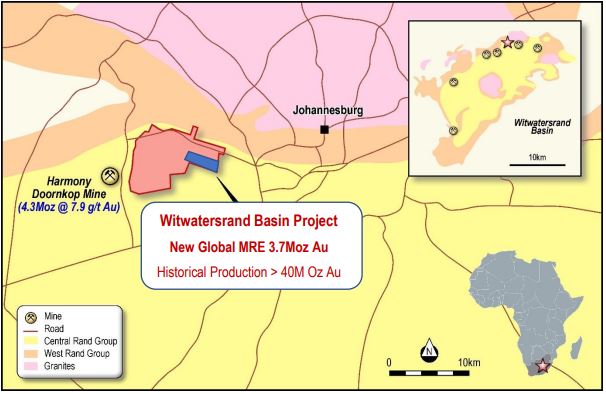West Wits’ gold resource in South Africa approaches 4m ounces
Mining
Mining
Special report: West Wits Mining has added more ounces to its already large gold resource in one of the world’s most prolific gold mining jurisdictions
The company’s (ASX:WWI) Witwatersrand Basin project in South Africa has grown by 428,000 ounces to 3.67 million ounces of gold.
The Witwatersrand Basin, or the Wits for short, is a geological formation that houses the world’s biggest known gold reserves, producing over 40 per cent of the world’s gold.
West Wits has also improved the confidence of the resource, with 2.4 million ounces now in the measured and indicated categories.
Mineral resources are categorised in order of increasing geological confidence as inferred, indicated or measured.
By moving resources into the indicated and measured categories, it means a company has sufficient information on geology and grade continuity to support mine planning.
Cash flow positive already
West Wits has already started small-scale mining in South Africa. Its goal is to become a mid-tier gold producer from a massive landholding in the Central Rand, which alone has produced over 247 million ounces.
The company remains focused on fast-tracking the Witwatersrand Basin project, which is now cash flow positive and self-sustaining, into full production.
“The board’s goal is to continue exploration work to further grow WWI’s resource and obtain the two applied for mining permits in the second half of 2018,” chairman Michael Quinert said.
“A solid recovery in gold production from the Kimberley Central open pit for May-June should underpin the necessary cash flow to continue funding project development as WWI prepares to scale up production over the balance of the year.”
West Wits’ project comprises two historic mining centres – Durban Roodepoort Deep and Rand Leases within the Witwatersrand Basin, forming part of the world’s largest goldfield.
Mining has been taking place within these areas since the goldfields were discovered in 1886.
During that time up to seven different gold-bearing conglomerate horizons were mined from surface down to 3100m.
Conglomerate gold refers to gold hosted in rock containing rounded grey quartz pebbles and other minerals.
Total past production for the combined Durban Roodepoort Deep and Rand Lease areas was over 40 million ounces at grades above 5 grams per tonne (g/t).
Harmony Gold Mining (JSE: HAR) reported production of 86,000 ounces of gold in the 2017 financial year from its Doornkop mine located directly adjacent to the western boundary of West Wits’ project.

Priority development
The increase in resource comes from a single conglomerate band known as “K9B”, which will be a priority for underground development once West Wits has the mining permit in hand.
The mining right is expected to be granted in the second quarter of 2019.
West Wits now plans to start work on defining a resource for another gold-bearing conglomerate, known as K9A, located in the same Kimberley Reef area.
Previous mining of both the K9A and K9B shows that both ore bodies can be developed and mined simultaneously using essentially the same infrastructure.
This special report is brought to you by West Wits Mining.
This advice has been prepared without taking into account your objectives, financial situation or needs. You should, therefore, consider the appropriateness of the advice, in light of your own objectives, financial situation or needs, before acting on the advice.
If this advice relates to the acquisition, or possible acquisition, of a particular financial product, the recipient should obtain a disclosure document, a Product Disclosure Statement or an offer document (PDS) relating to the product and consider the PDS before making any decision about whether to acquire the product.